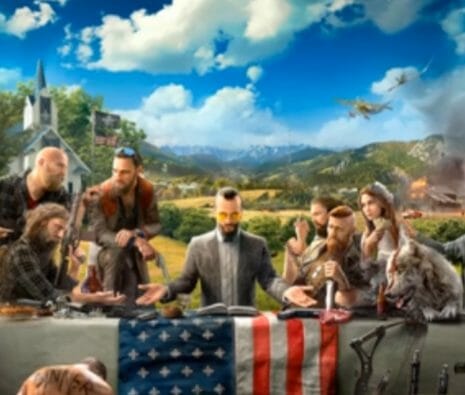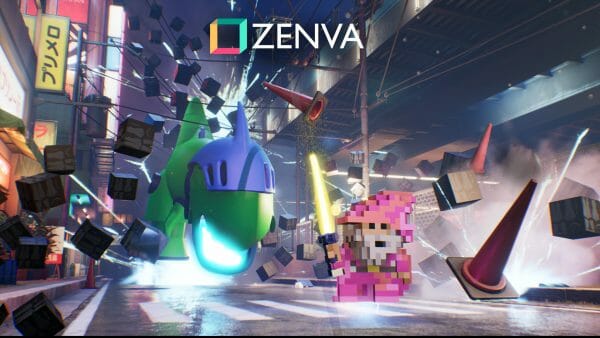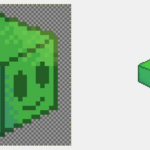You can access the full course here: Explore Storytelling for Games
Table of contents
The Protagonist
In this lesson, we’re going to be going over the protagonist. In storytelling– in movies, books, games, pretty much every storytelling narrative has a protagonist.
Who is the protagonist?
- The main character of a story
- In video games, you normally play as the protagonist.
- The more story-focused a game is, the more defined the protagonist will be.

In a game that’s not really story-focused at all, such as “Minecraft”, you don’t really know a lot about the player. There is no predefined history with the player in the game. Rather, it leaves it open to your imagination to play the game how you’d like and make your own stories along the way.
Whereas in games with a large story focus, like “Life is Strange”, the protagonists are well-flushed out, up to the point where we have full-on character arcs for the protagonist.
No Story Focus
Now let’s look at games with no story focus and how they utilize the protagonist.
Examples: Minecraft, No Man’s Sky, Online Competitive Games


- There is no protagonist, only the player.
- There are no story-focused conflicts, goals, or character building for the player.
- In many cases, the game is a foundation for you to create your own stories.
Moderate Story Focus
Examples: Halo, Doom, Mario games (most video games would fit into this category)


- The protagonist serves as a tool or driving force for the story rather than the focus.
- The protagonist may have goals (save the world, stop the bad guy) but have no development or change across the game.
Large Story Focus
Examples: Life is Strange, Firewatch, Telltale games


- The story is focused on the protagonist.
- They have goals, conflicts, and change throughout the game story.
Protagonist Goals
- To create an enticing protagonist, they have to want something.
- This should tie into the game plot and relate to the gameplay.
- e.g. save the world, be rich, defeat a villain, etc.
Examples:
- Firewatch: uncover the mysterious events happening around him.

- Far Cry 3: rescue his friends and become a warrior.

- Red Dead Redemption 2: take care of and protect your team from the outside world.

Protagonist Dialogue
Now, in lots of story-focused games, the protagonist is either spoken or silent.
- You’ll notice that video games have either a spoken or silent protagonist.
- This is a conscious decision made by developers based on the story and the importance of the protagonist.
Spoken Protagonist
- Protagonists with goals, conflicts, and the potential to change are normally voiced.
- It makes the character feel more real, and voice acting can emphasize: emotion, need, and personality.
- All things you want in a fleshed-out protagonist.
In games with predefined characters, motives, and progression through the story, like “Call of Duty 4: Modern Warfare” or “The Walking Dead”, characters are generally voiced. Voice acting can emphasize the character’s needs, personality, and emotion and make the character feel more real.


Silent Protagonist
On the other hand, games like “The Elder Scrolls V: Skyrim” or “Portal” (and many RPGs) where you are the character generally don’t have voice acting for the protagonist. This allows you to develop your character.
- Games with less of a story focus might go for the silent protagonist.
- RPGs where you are the character – don’t have voice acting.
- If they did, then seeing yourself in that character would be less immersive and limiting.


Spoken Protagonist in RPGs
- Most RPGs have a silent protagonist, but in “Cyberpunk 2077”, you have a voice.

- This is because although it’s still an RPG, the focus of the story is on you and your journey.
- You have character-specific (not player-specific) conflicts and goals throughout the game.
Challenge!
- Think of a story-heavy game you’ve played or know about.
- What did the protagonist want?
- What prevented the protagonist from getting it?
- How did the protagonist change throughout the game?
The Antagonist
In this lesson, we’re going to be looking at the Antagonist. Unlike the protagonist, the antagonist is the opposing force of the narrative.
Often, they’ll start the conflict, and the story aims to defeat the antagonist.
Who is the Antagonist?
- The villain or opposing force in the story.
- The protagonist is trying to defeat, stop or find the antagonist.
- They are normally the cause of the game’s main conflict.
Establishing
- If your game has an antagonist, they need to be established.
- Introduce them into the world and initiate the conflict.
- Many games establish their antagonist at the very start of the game.
Example: Skyrim

- At the very start of the game, Skyrim’s dragon antagonist attacks the town you are in and burns it to the ground.
- The conflict: dragons are back, and they are a danger to the world.
Example: Far Cry 5

- At the very start of the game, you and your team go to arrest the antagonist.
- He escapes and captures your team members.
- The conflict: your team members are being held, hostage.
Once the antagonist has been established, the next step we need to take is reinforcing the antagonist.
Reinforcing the Antagonist
- From the initial establishment of the antagonist to the confrontation at the end of the game, you want to reinforce them throughout the game further.
- This is very dependant on who they are, how much power they have and what they want to do.
Let’s take “Far Cry 5”, for example; you will get to know that the antagonist’s presence appears throughout the game. You’ll hear all his army talking about him, you’ll hear them on the radio, and there is a massive statue of the antagonist in the game that you can destroy, and wherever you go, you see hints of the antagonist. These are all examples of reinforcing the antagonist.
Anti-Hero
- Some games have you play a protagonist who isn’t all that good.
- This is known as an anti-hero.
- Someone who’s the main character, yet they lack heroic attributes.
- Examples: Grand Theft Auto, Infamous, Saints Row, Hitman

Also, some things to note are:
- Make sure that your anti-hero is likable.
- They should view their actions as a necessary means to reach a positive outcome.
- Side-characters can show anti-heroes redeeming qualities – e.g. GTA 5
Challenge!
Most games will have an establishment of the antagonist, and then at the end of the game, they will have sort of the final stand or the final battle of the antagonist to defeat them. Think about how this antagonist was established, their motives, and how their plans were laid out to the player.
- From a game you’ve played, who was the antagonist?
- How were they established?
- What conflict did they cause?
- How was their presence reinforced throughout the game?
Transcript
Protagonist
Hey everyone. In this lesson, we are going to be going over the protagonist. Okay, in storytelling, in movies, in books, in games, pretty much every single storytelling narrative has a protagonist. So first of all, who is the protagonist?
Well, basically the protagonist is the main character of the story and in video games, you normally play as a protagonist. So the character you are controlling in a game is the protagonist, is the main character who is going through the story.
Now, the most story-focused a game is, generally the more defined the protagonist will be. Okay, you’ll notice that in a game that’s not really story-focused at all, such as “Minecraft”. You don’t really know a lot about the protagonist. You don’t really know a lot about the player as it’s set up that way. You know, if there was a predefined history with the player in “Minecraft”, it would seem kind of odd. Rather it leaves it open to your imagination to pretty much play the game how you’d like and make your own stories along the way.
Then you got something like “Halo”, which has a bit of background on the character, you have some motives, but you know, it’s of course not a fully fleshed out character, because the story, although it is part of the game, it isn’t the core focus of the game. Yet, we go on the other side of the spectrum, which have a large story focus such as “Life is Strange”, which is basically a narrative game.
The characters and the protagonists in that game are very flushed out, even up to the point where we have full-on character arcs for the protagonist, okay? So you can see the sort of spectrum along video games on how important the protagonist is and defined they are based on how story-focused the game is.
Now let’s look at games with no story focus and how they utilize the protagonist. So in games with no story focus, there is generally no protagonist, only the player. When we say protagonist, we generally mean an actual character with a name, with some background and with some conflicts and wants and needs, but in games like “Minecraft” and “No Man’s Sky”, there is no protagonist.
There is only you, the player and you yourself define the goals, define the challenges, define the wants, the needs of your player. There are no story-focused conflicts, goals or character building for the player in these games. And in many cases, the game is a foundation for you to create your own stories. Sandbox games, creative games, the sort of games where the gameplay isn’t directly defined by the developer, rather it’s left open for you to explore and go about it at your own pace and some examples are “Minecraft”, “No Man’s Sky” and online competitive games.
So next up, we have moderate story-focused games, okay? This is where the protagonist serves as a tool or driving force for the story rather than the focus. So the gameplay, the action, what you’ll be playing as a player is more important than the story itself, but the story is there to serve as a foundation for guiding the gameplay.
The protagonist may have goals such as saving the world or stopping the villain, but they’ll generally have no development or change across the game. They’ll pretty much stay the exact same, but they will still have, you know, some motives to accomplish the goal. And some examples are “Halo”, “Doom”, the “Mario” games and pretty much most video games would actually fit into this category, because at the end of the day, video games are an interactive medium.
The main focus of video games is, I’d say to have fun and to play these games. So story isn’t necessarily the most important factor in games, but if games do have an important story and good gameplay, that is generally where they shine.
Okay, so next up, let’s look at large story focus games. These are games where story and the narrative is generally the focus point and the actual gameplay is, you know, not necessarily unique and it can be quite generic or limiting, because the developers are trying to have you focused on the story and this is of course, where the story is focused on the protagonist.
The protagonist is the center of the conflict, the center of the world in these sort of games and they have goals, conflicts and change throughout the story. If you watch movies with good character development, you’ll notice that you characters change across the story. The same goes for these sort of games. Some examples would be “Life Is Strange”, “Firewatch” and the “Telltale” games.
If you’ve played any of these games, you’ll know that these are heavily narrative-based games where there will be a lot of dialogue, a lot of story and they’ll generally be quite linear. There won’t be much room for you to move around and sort of go off the beaten track or go along and make your own stories, because these games are trying to tell you a specific story and you’re along for the ride.
So next up, we need to go over the protagonist goals. Now the protagonist goals are there to create an enticing protagonist. They have to want something. And this should tie into the game plot and relate to the gameplay, for example, saving the world, becoming rich, defeating the villain, et cetera. If you want a good well-defined protagonist, they have to want something. And the game is going to be their journey of trying to achieve it.
For example, in “Firewatch”, the goal of the protagonist is to uncover the mysterious events happening around him. In “Far Cry 3”, it’s to rescue his friends and become a warrior. In “Red Dead Redemption 2”, it’s to take care and protect his team from the outside world. In many story-focused games, you can find what the protagonist wants and how the game utilizes its gameplay in order for you to achieve that.
Next up, we have protagonist dialogue. Now, in lots of story-focused games and not story-focused games, the protagonist is either spoken or silent. So we have a spoken protagonist, which of course means a dialogue being spoken. You can hear it through your headphones or silent, where generally they won’t say anything at all or it would just be a short phrase that you can pick and it will be text-based.
Now this is a conscious decision made by developers based on the story and the importance of the protagonist. Now protagonists with goals, conflicts and the potential to change, are generally voiced. Okay, so you have a voice actor come in and record the lines and it will give them a specific emotion, a specific voice behind that character.
What this does, is it makes the character feel more real and voice acting can emphasize emotion, need and personality. And all the things you want in a fleshed out protagonist. So games like “Call of Duty”, for example, the campaigns have voiced actors, because these are characters who are predefined, you know, they’re not up to your imagination on what you want to make them.
They are predefined characters with goals, motives and progression through the story. Same thing with a lot of the “Telltale” games, such as “The Walking Dead”. Everyone is voice acted, because all these characters are important and all these characters serve a specific point to the story. And of course, you’re the protagonist.
Now, we have the silent protagonist and this is normally used in games with less of a story focus, they might go for a silent protagonist, especially in RPGs where you are the character and they generally don’t have voice acting at all for you.
They may for other characters, because those are well-defined characters with goals and needs and wants, but you yourself, you’re generally a blank slate, they allow you to develop your character. They allow you to choose what avenues you want to go down. And if they did have a voice actor for you in an RPG, then seeing yourself in that character would be less immersive and limiting.
Now, if we’re speaking of RPGs and silent protagonists or voiced protagonists, then we want to have a look at a example where we actually have a voice protagonist in an RPG. Most RPGs have a silent protagonist, but in “Cyberpunk 2077”, you actually have a voice. You can either be a male or a female voice in the game.
So why did the developers do this? Well, this is because, although it’s still an RPG, the focus of the story is on you and your journey. You can choose how you go about doing stuff, but at the end of the day, the story of the game is focused directly on you and your conflicts. Generally, in other RPGs, the conflict is either a villain or some other conflict in the world that the player has to solve, rather than the conflict being themselves.
Now, as a bit of a challenge, I want you to think of a story heavy game that you’ve played or know about and think of these three things, okay?
Well first of all, what did the protagonist want? What was they goal? What was their objective during the game? Secondly, what prevented the protagonist from getting it? Was there some sort of villain in the way? Was there some sort of obstacle that they had to overcome throughout the progression of the game in order to achieve their goal?
And finally, how did the protagonist change throughout the game? How were they at the start of the game and how were they at the end of the game and how did they change from being one type of person to another? Were they an angry person at the start and a peaceful person at the end? What was that sort of character arc progression? So have a go at that and thank you for watching.
Antagonist
Hey, everyone. In this lesson, we are going to be looking at the antagonist. Now, unlike the protagonist, the antagonist is the opposing force of the narrative. A lot of the time they’ll be the one that starts the conflict and the aim of the game or the aim of the story is to defeat the antagonist. Okay? The villain of the story.
So, first of all who is the antagonist? Well, they are the villain or opposing force in the story. Okay? The protagonist is trying to defeat, stop, or find the antagonist. And there are examples of this in pretty much every game a lot of games do have an antagonist and generally at the end of the game that is where you have your, you know, your final boss battle with them.
And they are normally the cause of the game’s main conflict, okay? Maybe they’re trying to end the world, maybe they’re trying to do something evil and it’s up to the protagonist to save the day.
Now it’s important to establish your antagonist in your game, okay? So if your game has an antagonist, they need to be established. You need to introduce them to the world and initiate the conflict. Okay. The player needs to be known of the antagonists presence and many games establish their antagonist at the very start of the game, okay?
You’ll notice many games such as Skyrim for example, at the very start of the game, even before you’re able to control your character, Skyrim’s main antagonist attacks the town you’re in and burns it to the ground, okay? And that initiates the conflict of dragons are back and they are a danger to the world.
Another good example is the Far Cry games. You can take pretty much any Far Cry game and they all follow the same formula of introducing the antagonist right at the start of the game, okay? “Far Cry 5,” for example, at the start of the game, you and your team go to arrest the antagonist who you’re introduced to, but he escapes and captures your team members.
And this creates the conflict of your team members are being held hostage and you of course, need to save them. And that is when the game plays out. Same thing goes for “Far Cry 4” and “Far Cry 3,” the main start of the game where you’re pretty much in a cut scene watching the players or not being able to control the player, that is where they’re introducing the antagonist.
And you’ll notice in a wide range of other games as well. Sometimes even before you can play the game, the antagonist is being introduced to you. And the lack of being able to control yourself or control the situation means that the developers are trying to show you the player the antagonist so that you have an idea of why you were doing the things you were doing in the game.
Okay? And throughout the game, you also want to reinforce the antagonist, okay? So from the initial establishment of the antagonist to the confrontation at the end of the game, you want to further reinforce them throughout the game. Okay. This can be a wide range of different things and it depends on who they are, how much power they have, and what they want to do, okay?
Let’s take “Far Cry 5” for example, if you’ve played “Far Cry 5” before, you will know that the antagonist’s presence is seen all throughout the game. There is a massive statue of the antagonist in the game that you can go and destroy, and that is just there to show you that they are basically controlling of the world around you and wherever you go, you see hints of the antagonist.
You know, you can hear them on the radio, you can of course see the statue, you can see all of his army talking about him, and the whole world sort of revolves around the antagonist and is there to establish and reinforce them and what they are trying to do.
Now, another concept we should go over is the anti-hero. Now some games have you play as a protagonist who isn’t all that good. You’re not necessarily the antagonist but you’re not a good hero either, okay? And this is known as the anti-hero.
You’ll see this in movies as well, many movies have an anti-hero main character, and this is basically someone who’s the main character yet they lack heroic attributes. They may be greedy, they may kill people, they made do illegal things, but in the end they’re doing it for good reasons, okay? Some examples are the Grand Theft Auto games, Infamous, the Saints Row games and the Hitman games, okay?
There are actually quite a wide range of games that do have an anti-hero. Also some things to note is make sure that your anti-hero is likable because the thing of making an anti-hero is that unlike making a protagonist which comparatively is quite easy, okay?
A protagonist, they have heroic attributes, they are basically the hero of the story. Whereas the anti-hero needs to be both bad yet likable and the balance between those two can be quite difficult. Okay? You need your anti-hero to do things that generally outside people would see as bad or evil yet from your perspective as playing with them or as being around them and hearing their story, it needs to be positive, okay?
They should view their actions as a necessary means in order to reach a positive outcome. Okay? So they should be doing things that may not necessarily be good, but they are doing it for a specific reason.
So as a bit of a challenge, I want you to think of a game that you’ve played or that you know of and think of who was the antagonist. Okay? And I want you to basically think of these three things, first of all, how was the antagonist established, okay? How were they introduced to both you and the player in the game and what conflict did they cause? What is the main issue of the game that you as a player need to solve and does that revolve around the antagonist?
And finally, how was their presence reinforced throughout the game? Okay? Most games will have an establishment of the antagonist and then at the end of the game they will have sort of the final stand or the final battle of the antagonist to defeat them.
But between that start of the game and the end of the game, how was this antagonist re-established? How were their motives how was their plans basically laid out to that player? You know, how did the player know constantly throughout the game that the antagonist is still a presence in the game world, okay? So, have a go of that and thank you for watching.
Interested in continuing? Check out our all-access plan which includes 250+ courses, guided curriculums, new courses monthly, access to expert course mentors, and more!






